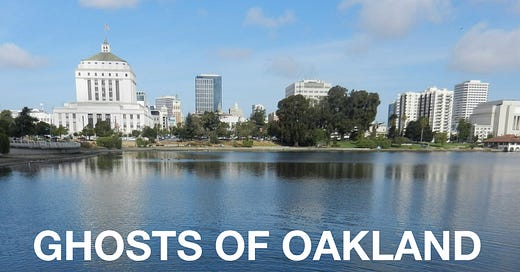On the days when I wake up somewhat early when the light is barely pushing into my window from the sky that creeps into the alley, all I want to do is remain silent and still. I make my coffee and sit in the kitchen. I’ll hear the garbage trucks, the squeaking of brakes coming to a stop — likely some close call on the chaotic intersections of my neighborhood. I hear other cars speeding, the distant hum of a train, and the highway. All these human noises fill the air. But then, I’ll hear a California towhee, or a crow. Sometimes I can hear the Canada geese passing overhead, or the lilting chirps of a house finch. And, of course, the endless calls of gulls. I often picture where these birds would be if Oakland wasn’t here. What other calls we could’ve heard before this city was built?
For thousands of years Lake Merritt and Oakland were a small appendage, an arm of the Bay itself, thousands of acres of wetlands where Ohlone people, the rare sora’s and bitterns of the marshes, and night herons, thrived. This was all before the Spaniards, the French, the Dutch, the British came to conquer both a land and people who were finally living equanimously with each other. This was before Europe arrived and decided that marshes were not sightly, were impractical places that could be made better use of with roads, homes, shops, and notions of progress and commerce. This, yes, was a long time ago.
But not so long ago to be some little after thought, some ancient and tragic story of the foolish creators of this city which I now call home. It was just over 250 years ago that Spanish conquistadors claimed the land for Spain. This is no ancient past. And that is still felt here today.
Walking this morning around Lake Merritt, which is really a closed-in estuary (that’s why it smells like the ocean and dead fish), I looked down into the water and saw two bat rays swimming quickly to the outlet, maybe heading back into the greater bay. There were American white pelicans bobbing for food, already here, a frequent stop and home for their non-breeding days. Snowy egrets, coots, and so many other waterfowl out there, making do with this altered but not completely unchanged landscape.
However, the bird that shows the land’s marshy history best is the black-capped night heron. Easily mistaken for a sea gull, you can see them everyday lining the lake, staring with resolute stillness into the water, almost as if they were reflecting on their own existence.
What’s most odd about them in Oakland, along with a handful of other urban areas, is their total comfort in the chaos of a city. Growing up with them in Marin County, I’d rarely see them in the streams in town, and could only find them out in the marshes surrounding the bay. But here, I’ve seen them pick through trash, stand on telephone lines and poles in the middle of downtown, and get into small fights with seagulls for sidewalk scraps.
Jenny Odell, in her book How to Do Nothing, sees them as a remnant of the watery past of Oakland, a remnant of the marshes we dredged to replace with all this concrete. In a 2018 article in Sierra magazine, she writes:
“The herons have existed in Oakland since before Oakland was a city. Like crows, part of their success has been adapting to the human environments built up around them. They’ll readily eat trash, do not seem to mind traffic, and will nonchalantly stand in the middle of a sidewalk downtown. Resolute in both space and time, night herons are the stocky ghosts of marshes past.”
What’s odd is that so many stay in Oakland, that there is a population that lives year-round in the city itself, almost waiting for the waters to return. But I don’t want to psychoanalyze them too much.
To put it simply, this city, full of speeding cars, wild characters and hot takes from the world outside of it, a place that so many people in the Bay, the nation, and abroad, look to with fear, neglecting to see so much of the beauty of living here. The history of this place, both natural and human, is still fresh, still so directly tied into each other that they cannot be separated. This land once was thousands of acres of marsh. We see concrete, chaos, a challenging place to navigate, but we also see a beautiful and fraught history. A place that is here, despite who decides to not see it there. The sounds of the birds every morning outside my apartment are a small reminder to me of the beauty of Oakland, despite its challenges.








